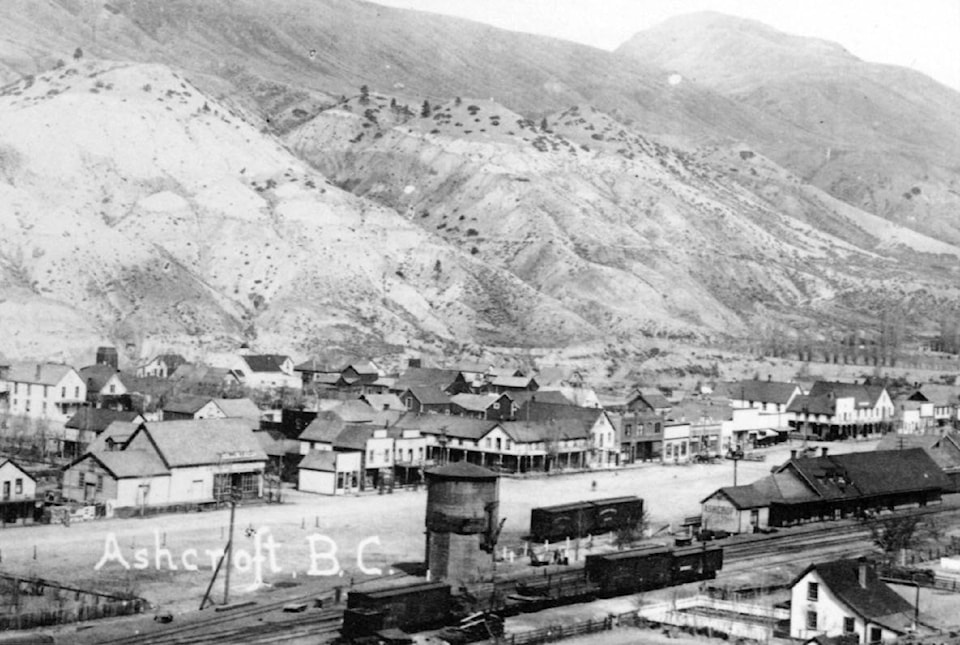Unlike many B.C. Interior towns, which went into decline when the gold rush that started in 1858 was over, Ashcroft thrived, due in large part to the CP Railway train station and depot in town. For many years it was the northernmost train destination in the province, and this attracted merchants and businessmen even before the railway was completed.
Within a few short years the town was booming. Foster’s General Store had been established by the time the first known photograph of the town was taken, between 1889 and 1892. The Ashcroft Hotel had been established at the corner of Railway and 4th, and there were two more hotels further along the street: the Grand Central at the corner of 3rd and Railway, and the ill-fated Cargile Hotel, where the Credit Union is now located; ill-fated because it blew down once, and was burned down twice, before the owners decided to call it a day in 1916.
The 1887 B.C. Directory lists some 80 men, and one woman, already doing business in Ashcroft. By the turn of the 20th century, Ashcroft was in its heyday, with a population of more than 600. A thriving Chinatown had sprung up at the north end of Railway Avenue, and the town had electricity (many small towns in the province were not serviced by electricity until the 1940s and 1950s). Ashcroft had been promoted, after the discovery of gold in the far north in 1898, as “The Poor Man’s Route to the Yukon”, in an effort to entice some of the 200,000 would-be miners who were expected to head north to the Klondike.
A promotional brochure titled “Ashcroft: The Gateway to Northern British Columbia”, published by The Journal in 1909, extolled the town’s virtues. The opening page of the pamphlet reads, “Ashcroft is easily one of the most important towns in the Interior of British Columbia, and few towns in the province are better known to the mining and commercial interests of not only Eastern Canada but also the United States and Great Britain. The town has a prosperous and industrious appearance, with its many ranchers shipping cattle and farmers unloading wagons of produce consisting chiefly of the famous ‘Ashcroft potatoes’.
“The town is well equipped with all modern conveniences: three churches flourish, a public school, two good hotels [once again the poor Cargile Hotel gets short shrift], numerous general stores including one of the largest in the province. Ashcroft has an excellent Electric Light and Water service, also a Volunteer Fire Brigade and Board of Fire Wardens. A branch of the British Bank of North America is established here and the medical and legal professions are likewise ably represented by a resident doctor, two legal firms, and a County Court judge.
“The CPR agency and telegraphs, including the southern terminus of the Ashcroft–Dawson line, is located at this point, and telegrams are distributed east and west all over the world. The British Columbia Express Company, whose head offices are at Ashcroft, operate stage lines over 600 miles in length through the Cariboo, Chilcotin, and Lillooet districts, carrying mails, passengers, express, and fast freight in most expeditious manner.
“The town also boasts of an up-to-date newspaper. The Ashcroft Journal, which was established in 1895, gives reliable information of the Yale–Lillooet–Cariboo Districts and Northern British Columbia, and contains all the mining and agricultural news of these rich sections of British Columbia.
“Devotees of sport can find many a branch in which to indulge their fancy as tennis, baseball, bowling, basketball, curling, and rifle clubs are in full swing, while disciples of Isaac Walton [author of the famous work The Compleat Angler (1653), which celebrates the art and spirit of fishing] can enjoy most excellent trout fishing in the Thompson River, the fish mostly of the silver and rainbow species, running from one to 12 pounds. The climate is everything that can be desired, the winter being neither too cold nor too snowy, and yet just cold enough to make ice for curling and skating.”
What the pamphlet fails to mention is Ashcroft’s thriving social scene, which had earned it the reputation of being a very progressive town in the otherwise uncouth Cariboo region. J.C. Barnes had donated a piece of property located at 4th and Brink to the town, for the construction of a town hall, and the resulting building became the Opera House, which attracted performers and orchestras from all over North America; the celebrated Canadian poet Pauline Johnson presented an evening of readings from her works, interspersed with comedy and impersonations of notable people of the day. Another early performer at the Opera House was Beatrice Campbell, whose grandson is Canadian singer/songwriter Ian Tyson.
Literary evenings and musical recitals were popular pastimes. In those days before radio and television, and with films in their infancy, people were used to creating their own entertainments, and almost everyone would have had some performing talent, whether it was playing a musical instrument, singing, or reciting.
In 1915 a library, Ashcroft’s first, was established in a room at the Ashcroft Hotel. A Pioneer Society was formed, with membership limited to those who had come to the area no later than 1864; the last dinner of the Society was held in 1910. A Grand Ball was held every year, with out-of-towners arriving days in advance and filling up the town’s hotels. Town picnics were held on the Victoria Day and Labour Day weekends, and the ranchers formed a local chapter of the BC Agricultural Association. Their first Fall Fair was held in 1888, in a building erected on the site of what is now the Village Office. A Robbie Burns Society was founded in 1899, and 40 people came to their first dinner.
While many of these businesses and organizations are long since gone, Ashcroft continues to thrive a century later. Think that nothing happens in a small town? Think again.
editorial@accjournal.ca
Like us on Facebook and follow us on Twitter
